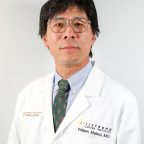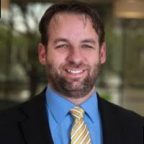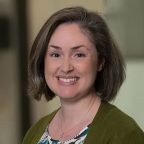At the one year anniversary of the podcast, Nick Smith-Stanley, MBA interviews William Matsui, MD and Summer Undergraduate Research Fellow Kennedy Price about their work in multiple myeloma research and discusses why representation in cancer care and cancer research matters.
This episode of Cancer Uncovered was mixed and mastered by Harris Codini and Morgan Honaker.
Guests
 William MatsuiThe Deputy Director of the Livestrong Cancer Institutes at the Dell Medical School at the University of Texas at Austin
William MatsuiThe Deputy Director of the Livestrong Cancer Institutes at the Dell Medical School at the University of Texas at Austin Kennedy PriceSummer Undergraduate Research Fellow at the Dell Medical School at the University of Texas at Austin
Kennedy PriceSummer Undergraduate Research Fellow at the Dell Medical School at the University of Texas at Austin
Hosts
 Nick Smith-StanleyAssociate Director of Administration and Strategic Planning at the Livestrong Cancer Institutes
Nick Smith-StanleyAssociate Director of Administration and Strategic Planning at the Livestrong Cancer Institutes Kristen WynnSenior Administrative Program Coordinator at the Livestrong Cancer Institutes
Kristen WynnSenior Administrative Program Coordinator at the Livestrong Cancer Institutes
We are a resource for learners, including every member of the live strong cancer institutes on track educational pipeline from middle school to residency, we are a growing collection of interviews, talks and experiences, the uncover, the myths and the uncertainties of cancer and careers in cancer in order to empower and inspire generations of thinkers and leaders.
This is cancer. An education and empowerment podcast by the live strong cancer institutes.
Each summer, the live strong cancer Institute at UT Austin’s Dell medical school introduces undergraduate students to cancer and research through the summer undergraduate research fellowship, or what we call surf during surf students spend the summer working on independent research projects with cancer researchers throughout Austin students also attend lectures to learn about cancer subspecies.
And research methodologies in 2021, the LCI introduced an additional lecture series to focus on issues relating to anti-racism diversity, equity and inclusion. For many of us in oncology or personal connections in cancer drives the work we do every day for one particular student, the loss of someone close to her is her motivation to learn more about cancer and research through the surf program.
This month on cancer. We hear from a current surf student and how she became interested in science, oncology and research. But first LCI, deputy director and professor of oncology, bill Matsui joins us to tell us more about hematological malignancies and multiple myeloma and aggressive form of cancer that forms in the body’s white blood cells.
Dr. Matsui is also the associate chair of research and specializes in the diagnosis and treatment of cancers that involve the blood bone marrow and lymph nodes. This is cancer uncovered.
Multiple Loma is really a disease of a cancer of the immune system. So the immune system, a critical part of it is the part that makes antibodies. So when you see some sort of pathogen or a virus and you’re exposed to it, your body is supposed to take that information to make an antibody against it. So that’s.
Essentially what we’re trying to do by vaccinating people against COVID. So the cells that make antibodies are called plasma cell. And there are about 1% of the cells in your bone marrow. They live in the bone marrow. And so their job is really just to be factories that make antibodies and multiple myeloma is a cancer of those cells.
So we don’t have a firm grasp on what. People get myeloma or not. There are definitely some things that people can be exposed to that increased the risk that you might get by Loma. So a couple of interesting ones are one is if you’ve been exposed to like large amounts of radiation, And survive that then you can develop my Loma.
So that was something where a lot of people who were survivors of the nuclear bombing in Japan, many of them developed myeloma there’s some relationship between sort of a more benign form of myeloma called MGUS and exposure to agent orange. And so a lot of veterans who were exposed to agent orange, Oh condition that looks like my Lama.
And then there’s been this interesting link between people who were rescue workers during nine 11. They, for some reason have a high incidence of multiple myeloma. So it’s unclear whether there was some environmental exposure that happened. There there’s been a familial link, but that is very rare. But in general, It is unclear what the causes for most people, and it tends to happen in older folks.
And so it’s very rare that you might see multiple myeloma in a child and the average age at which one gets diagnosed with myeloma as well into your seventies. And so it’s really one of these things that you’re susceptible to like heart disease. You know, Alzheimer’s like, it’s a disease of aging, essentially.
So that plays an important role in probably the development of the disease, but just like those other conditions, we have no idea of why that happens. The prognosis for patients with myeloma, you know, it’s changed over time. So for the disease itself. So just having, you know, if it’s a cancer, then you have increased numbers of plastics.
So that defines myeloma, there are conditions that are related to my Loma, where you have increased numbers of plasma cells, but you don’t have the manifestations of the disease. And so those are called precursor conditions. And so I mentioned one called MGUS. So the prognosis for those individuals is very good.
That condition can become my Loma, which is the cancer. And for MGUS, that happens at 1% per year. So if you. Live 50 years, you have a 50, 50 chance of getting my Loma. There’s another condition called smoldering myeloma, which is even more plasma cells, but it doesn’t affect your body. And that has a 10% chance per year of turning into myeloma.
And what distinguishes those two conditions from the actual disease is that it. Myeloma. There’s some part of it that is actually harming your body. So the common manifestations are kidney problems, bone problems. So you can break a bone. Anemia is also associated with it. And then the fourth thing is something called hypercalcemia where you applied levels of calcium in your blood.
So if you have an increased number of plasma cells, but you don’t have any of those other problems, then you don’t have mine. It’s only when you have one of those other conditions that we say you have the cancer. So when patients get diagnosed with the actual myeloma, we tend to tell people that, you know, the average length of time that they might live is between three and five years.
So when I started taking care of my lumber patients, about 20 years ago, we would retreat only say, you know, it’s going to be between two or three years. The disease is incurable, uh, by most treatments. And so, you know, we treat people and then unfortunately they’re not cured and they die even though. Cure rates are still very low.
There’ve been many advances in the treatment of myeloma. So in the last 20 years, there have been over a dozen new cancer therapies for myeloma. And with that, the average length of time that people. Clearly exceeds five years and may even exceed 10 years. And so the interesting thing about my Loma is it’s become a very acute condition where you can die in a couple of years to now a very chronic condition where you have it and you’re getting treated and you’re getting treated for a long time, but it may be many, many years before something happens.
And I have, you know, many patients that have had the disease for more than 20 years. There are some groups of individuals that have an increased risk of getting the disease. And so one group that stands out would be African-American. Especially African-American males have a higher incidence of the disease, and it’s not clear why that is.
There’ve been efforts to look at the genetic changes that happen in my Lomas. Patients who are black versus patients who are not black and there are specific genetic differences, but we don’t know how that drives the disease. And so it is one of the handful of cancers where there’s a racial disparity, right.
And it’s not in sort of the treatment of the disease. It’s sort of like who gets it. And my Loma is one where there’s a, a much greater increased risk. Blacks. And then prostate cancer is another one. Breast cancer is another one, but of the blood cancers. Myeloma is the only one that has a racial disparity and, or a racial difference in its incidents and myelomas.
That condition Kennedy price is a rising sophomore at Howard university in Washington, DC. Originally from central Florida, Kennedy is studying chemistry and sports medicine in hopes of attending medical school. I first became interested in chemistry, my junior year of high school. That is when I took my high school chemistry.
And I also took AP chemistry. Chemistry for me came really naturally and pretty easy. I really enjoyed the subject. I loved my teachers and my professors now, and then sports medicine being an athlete. I just really loved anything athletics and I actually was injured quite often. So I found myself at the orthopedic doctor and the sports med clinic at my high school.
Um, and I kind of wanted to learn the other side. How do you go from a chemistry student and sports medicine to oncology? So I have a family history of cancer starting back, actually with my great-grandparents. So my great-grandmother had it and it runs on both sides of my family. So my uncle had it, my grandfather and so on.
And then most recently my dad had multiple myeloma. He actually got diagnosed in 2011, they were able to catch it early enough. So, uh, they, you know, took his bone marrow, saved it, and whenever he needed a few years later, he was able to be his own donor. And I think that was really great and really essential too.
His treatment. And so he passed away in 2019, but whenever you look at the statistics, multi myeloma typically has a five-year survival rate. So he was able to survive for eight years and he lived a phenomenal life. He had great quality of life, great oncologists that were just able to make sure that he was able to the best of his ability continue his day to day activities.
And that’s kind of how I became interested more so in oncology, just because I saw him going to his doctor’s appointments, getting blood transfusions, all those kinds of things. And I found myself asking the doctors, the oncologists, all these different questions. So you mentioned during your dad’s treatment, he was able to sort of outlive his expectancy.
Um, do you think there was anything in particular that, that helped lead him to that? He had a strong faith and he had a pretty healthy lifestyle. And I think that really helped him as his cancer started to become more aggressive. And he also actually had two black, multiple myeloma specialist, Dr. Hixson, Dr.
Ephemera, and they were really essential to his treatment. And I think that really helped him just having someone that looked like him to treat him as a young person who. Really had two roles. Uh, you were a child of someone who was going through this treatment, but also someone who was developing interests in education, your career.
Uh, how important was that for you in that representation of seeing two black doctors? Oh, it was so important. And to this day I am calling them, updating them, everything that’s going on, um, and our surf program. And I actually consider them both as two, as my professional mentors, just because they have really helped me navigate.
And they kind of actually helped me prepare for this program just because, you know, they are in the field of multiple myeloma and they knew that is what I was researching. So for any person, no matter. Field you want to go into, you always need to see representation. You have to have someone to look up to, and sometimes whenever you’re going into this field, there’s not necessarily that representation someone that you’re able to 100% relate to.
And I think that’s been a challenge for me, but I will say that I’m blessed to go to an HBCU, which is a historically black college. So a lot of my peers, a lot of my professors, a lot of my mentors have similar experiences too. What would you say to a student, particularly a woman of color who is interested in a program like surf, but they may have some concerns about representation.
What would you say to them? I do want to say that I really appreciate that our group of fellows this year is very diverse. On Wednesdays, we have the anti-racism lectures and I think it promotes a great conversation of the disparities that we see in healthcare that just aren’t talked about enough whenever we’re having these lectures on Wednesdays.
I love just to hear the stories of everyone else. You know, everyone has a different experience, just if you’re, you know, they’re same race, same background, you know, person that’s having the same experience. So I’ve really loved just going into those breakout rooms. Having those discussions and talking with everyone, I think oftentimes the topic of racism can kind of just be put in a bubble, but there’s a lot to unpack, especially in healthcare, especially the disparities.
And so I have really just loved hearing the different things that we as future healthcare professionals are able to do to just make sure that we can eliminate those biases, eliminate those disparities in that. That connection to cancers is super important when we talk about these educational programs.
And so we were excited that you were able to work with Dr. Voll Matsui, who one of his specialties is multiple myeloma. So can you talk about a little bit about your experience so far in surf and working with bill? I have absolutely enjoyed being in surf so far. I have never been in a lab setting except for high school this year being COVID and it being my freshman year, I was not on campus and I was not able to get into my chemistry lab.
So I’ve really enjoyed learning under my senior scientists the past few weeks to G Wang. And she’s just been able to teach me the ropes of the lab, teach me all the basic things that I need to know. So it just like pipetting and all the different protocols. Um, so with surf, all the students get to work on an independent research project.
So can you tell us a little bit about what specifically you are working with with bill and his team? Bill’s lab is a multi myeloma research lab. And I feel like multiple myeloma it being so rare. There’s so much to learn from it. And so what I am doing specifically is I’m understanding a specific gene called Sox two.
So Kennedy is trying to. Figure out what exactly makes my Loma hang around and stay around so you can never cure it. And one of the thoughts is that for something to keep growing forever, it’s not like every cell in your body can do that. There are certain cells and most of them are stem cells that are able to live forever produce, you know, cells forever.
And so we think that there’s some parts of cancers. Myeloma included that have that aspect of like sort of stem cell properties or stem cell features. So she studying a gene called Sox two and Sox two is something that’s very important when embryos develop. And it’s very important for a lot of stem cells, especially within the brain.
So I am setting socks, two’s role and drug resistance. And hopefully once I collect all of this data, this will kind of contribute to a bigger picture project that will continue once I leave the program. And the other scientists will be able to kind of understand just multiple myeloma as a whole and it’s drug resistance.
So hopefully those patients that are dealing with this, there will be other therapies developed that will treat their cancer. When you’re working in the wet lab with bill and his team, how much conversation do you have about actual patients and how your work will hopefully impact their care? That’s actually a question I ask pretty much every day, just because I think sometimes whenever you’re just looking at a cancer cell line, it’s like, you know, this isn’t an actual patient, so I’m constantly talking to, to Gina.
I’m like, how, how does this help someone, you know, She actually has showed me like, you know, okay, these are all the papers that we’ve been able to publish. And I think that it’s really interesting that bill is still a practicing oncologist as well. So once these things are, you know, they’re proven he can kind of take those into the clinic with him and work with his patients as you know, as well as other multiple myeloma doctors across.
I want to talk a little bit more about your goals beyond the surf program. You’ll be wrapping the program up here in August with a poster session. So what, what do you plan to do after surf and what do you think you’ll be able to take from this experience to your future? First and foremost, I think research is just a phenomenal way to get your foot in the door and to kind of this field.
So I hope to continue researching throughout my college years. And hopefully when I start practicing medicine as well. So I do want to go to medical school. I’m not quite sure what I want to do specifically, but I do know I want to work in the nonprofit sector, whether that is overseas or. You know, and underserved communities across the United States, for me, success looks like being out in the community, making a difference.
I really want to, hopefully in the far future train the, the next physicians and just kind of help them eliminate those biases, making sure that they’re giving holistic healthcare just because not every patient is going to be the same. I have learned that over the years, just shadowing physicians, volunteering at hospitals, that everyone kind of deserves their own treatment.
No one, no one is the same. So I would really love to just be out in the community, making a difference, hopefully, um, going overseas as well and doing some humanitarian work as well. I have learned this so much in this program. I have grown so much, and I think that whenever you come to Austin and you come to Dell medical school, you will see that representation, everyone here will be sure to support you, to make sure that you are welcome and to help you navigate into this new field.
I think that the biggest. That a program like surf can play is to just allow people to gain exposure to research and how research has done. I’ve been doing this for 20 years, right? Have I come closer to curing myeloma than when I started. I don’t know. I don’t think I have. Right. I think we understand the disease a little bit better, but it’s not something I’ve done.
That’s cured it. And so really it’s people like Kennedy who are going to be able to do this. Our hope for someone like Kennedy is she likes it. She thinks it’s a worthwhile endeavor. And she goes, she cures myeloma 10, 20, 30 years from now. I want to thank Dr. Matsui for his expertise as well as Kennedy for sharing her powerful story.
For more information on the summer undergraduate research fellowship. Visit our website@dellmeddotutexas.edu applications for the 2022 summer session will be accepted starting October 1st. I’m nix Ms. Stanley with the live strong cancer institutes. Wait just a moment. This is Kristin. When with the live strong cancer institutes interrupting the conclusion of this episode with two important messages.
Number one, cancer uncovered an education and empowerment podcast by the live strong cancer institutes. Turned one year old, one year of monthly discussions on cancer care, cancer research, careers in cancer, professional, and personal development skills, and so much more. We hope this podcast has uncovered new things for you and has motivated you to pursue what inspires you because you dear listeners and learners drive our podcast, our organization, and the future of cancer.
Forward. So we look forward to continuing this educational podcast journey with you. Number two, the reason this podcast exists is because I stormed into Nick’s office early one morning and declared that we needed a podcast and without a beat, he said, yes, we do. Now, please go figure that out. Please join me in a heartfelt bittersweet.
So long to our LCI colleague, Nick Smith Stanley. This was his last episode of cancer uncovered because he is leaving the LCI to pursue awesome work in the cancer community. Nick, the first person hired at the LCI started this cancer center from the ground up. We are so thankful, Nick, for your hard work, your leadership and your vision.
You will be missed around here, but we’re so excited to see what comes next for you. All right. That concludes this episode’s interruption. Thank you as always for listening and learning with us, and this has been cancer. If you’d like to learn more about the live from cancer institutes or have ideas of topics we can uncover email us at live strong cancer institutes at Dell med, texas.edu.
Please make sure Institute is plural. You can follow her record on Twitter at S Gail Eckhart at Cartus, spelled E C K H a R D T. And of course, if you enjoyed this episode, please subscribe.